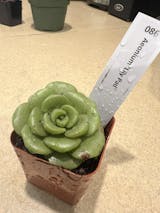About Aeonium Lily Pad
Aeonium Lily Pad is a succulent plant belonging to the Crassulaceae family. Its leaves are similar in shape to lily pads, flat and round, thick and juicy, and usually green. The plant has an attractive appearance with tightly arranged leaves. Aeonium Lily Pad tends to grow into woody stems.
How to care for Aeonium Lily Pad
Sun/Temperature: Aeonium Lily Pad prefers ample sunlight but should be protected from intense sunlight, especially during hot summers. The ideal temperature range falls between 60 and 75 °F. Since it is not tolerant to cold temperatures, it should be brought indoors during winter.
Soil/Watering: Use a well-draining soil mixture of sand or gravel. They prefer a dry environment. Water the plant when the soil is arid to avoid overwatering. The plant has shallow roots and is susceptible to damage from overwatering. If water accumulates and remains on them, the leaves can quickly rot.
Pot: Choose pots with drainage holes to facilitate proper drainage.
Pest and Disease: Aeonium Lily Pad is prone to aphids, mealybugs, and ants. If pests are detected, use soapy water for treatment. Other than that, a common pest problem with Lily of the Valley is spotting, which can be caused by overexposure to sunlight, too much or too little water, pests and diseases, insufficient nutrients, and too high or too low temperatures. If spotting occurs, check for these factors and take appropriate action to solve the problem on a case-by-case basis.
Propagation: Aeonium Lily Pad can be propagated through stem or leaf cuttings. The best time for propagation is in spring or summer. The method involves cutting stems with attached leaves from the parent succulent, letting the wounds dry, and then planting them in potting soil.
Fertilization: Aeonium Lily Pad benefits from fertilization and can be fertilized during the growing season. Choose a balanced nutrient fertilizer and avoid over-fertilization to prevent plant harm.
More Information
Primary color: Green
Secondary color: Yellow/Orange
Bloom color: Yellow
Cold hardiness: USDA Hardiness Zones 10 to 11 (from 30°F to 50°F)
Product format: Rooted in 2 " pot
Suitability: Ideal for balcony, Window, Garden
Propagation: Easy by stem cutting
Special characteristic: Pet safe









